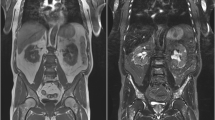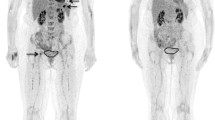Abstract
Objectives
The current analysis investigated the prognostic significance of gadopentetate dimeglumine on survival and renal function in patients with monoclonal plasma cell disorders.
Methods
In this study 263 patients who had received gadopentetate dimeglumine within a prospective trial investigating dynamic contrast-enhanced magnetic resonance imaging (MRI) were compared with 335 patients who had undergone routine, unenhanced MRI.
Results
We found no significant prognostic impact of the application of contrast agent on progression-free survival in patients with either monoclonal gammopathy of undetermined significance, smouldering or symptomatic myeloma and no significant prognostic impact on overall survival in patients with symptomatic myeloma. Since renal impairment is a frequent complication of myeloma, and decreased renal function is associated with a higher risk of complications in patients receiving contrast agents, we evaluated the impact of contrast agent on renal function after 1 year. In the present analysis the only significant adverse impact on kidney function occurred in symptomatic myeloma patients who already had impaired renal parameters at baseline. Here, the renal function did not recover during therapy, whereas it did so in patients with normal or only slightly impaired renal function.
Conclusion
If general recommendations are adhered to, gadopentetate dimeglumine can be safely applied in patients with monoclonal plasma cell disease.
Key Points
• Application of gadopentetate dimeglumine has no adverse prognostic effect in plasma cell disorders
• Renal function is not influenced by gadopentetate dimeglumine in asymptomatic myeloma patients
• Adherence to general guidelines is sufficient in myeloma patients

Similar content being viewed by others
References
Baur-Melnyk A, Buhmann S, Becker C, Schoenberg SO, Lang N, Bartl R et al (2008) Whole-body MRI versus whole-body MDCT for staging of multiple myeloma. AJR Am J Roentgenol 190:1097–1104
Zamagni E, Nanni C, Patriarca F, Englaro E, Castellucci P, Geatti O et al (2007) A prospective comparison of 18 F-fluorodeoxyglucose positron emission tomography-computed tomography, magnetic resonance imaging and whole-body planar radiographs in the assessment of bone disease in newly diagnosed multiple myeloma. Haematologica 92:50–55
Walker R, Barlogie B, Haessler J, Tricot G, Anaissie E, Shaughnessy JD Jr et al (2007) Magnetic resonance imaging in multiple myeloma: diagnostic and clinical implications. J Clin Oncol 25:1121–1128
Hillengass J, Fechtner K, Weber MA, Bäuerle T, Ayyaz S, Heiss C et al (2010) Prognostic significance of focal lesions in whole-body magnetic resonance imaging in patients with asymptomatic multiple myeloma. J Clin Oncol 28:1606–1610
Fulciniti M, Sundararaman S, Nanjappa P, Amin SB, Chevireddy P, Gokden N et al (2009) Gadolinium containing contrast agent promotes multiple myeloma cell growth: implication for clinical use of MRI in myeloma. Blood 114:1841
Kyle RA, Gertz MA, Witzig TE, Lust JA, Lacy MQ, Dispenzieri A et al (2003) Review of 1027 patients with newly diagnosed multiple myeloma. Mayo Clin Proc 78:21–33
Hillengass J, Zechmann C, Bäuerle T, Wagner-Gund B, Heiss C, Benner A et al (2009) Dynamic contrast-enhanced magnetic resonance imaging identifies a subgroup of patients with asymptomatic monoclonal plasma cell disease and pathologic microcirculation. Clin Cancer Res 15:3118–3125
Grobner T (2006) Gadolinium–a specific trigger for the development of nephrogenic fibrosing dermopathy and nephrogenic systemic fibrosis? Nephrol Dial Transplant 21:1104–1108
Rosenbaum PR, Rubin DB (1983) The central role of the propensity score in observational studies for causal effects. Biometrika 70:41–55
Schmoor C, Gall C, Stampf S, Graf E (2011) Correction of confounding bias in non-randomized studies by appropriate weighting. Biom J 53:369–387
Xie J, Liu C (2005) Adjusted Kaplan-Meier estimator and log-rank test with inverse probability of treatment weighting for survival data. Stat Med 24:3089–3110
Lee BK, LesslerJ SEA (2011) Weight trimming and propensity score weighting. PLoS One 6:1–6
Mitra R, Reiter JP (2012) A comparison of two methods of estimating propensity scores after multiple imputation. Stat Methods Med Res(Jun 11)
Ridgeway G, McCaffrey D, Morral A, Griffin BA, Burgette L (2013) Twang: toolkit for weighting and analysis of nonequivalent groups. R packageversion 1.3-20. http://CRAN.R-project.org/package=twang
Lumley T (2004) Analysis of complex survey samples. J Stat Softw 9:1–19
R Core Team (2013) R: A language and environment for statistical computing. R Foundation for Statistical Computing, Vienna, Austria. http://www.R-project.org
Scheid C, Sonneveld P, Schmidt-Wolf IG, van der Holt B, Jarari LE, Bertsch U et al (2014) Bortezomib before and after autologous stem cell transplantation overcomes the negative prognostic impact of renal impairment in newly diagnosed multiple myeloma: a subgroup analysis from the HOVON-65/GMMG-HD4 trial. Haematologica 99:148–154
Spinnato P, Bazzocchi A, Brioli A, Nanni C, Zamagni E, Albisinni U et al (2012) Contrast enhanced MRI and 18 F-FDG PET-CT in the assessment of multiple myeloma: a comparison of results in different phases of the disease. Eur J Radiol 81:4013–4018
EMA (2009) European Medicines Agency makes recommendations to minimise risk of nephrogenic systemic fibrosis with gadolinium-containing contrast agents. Press release EMEA/CHMP/739818/2009
Sadowski EA, Bennett LK, Chan MR, Wentland AL, Garrett AL, Garrett RW et al (2007) Nephrogenic systemic fibrosis: risk factors and incidence estimation. Radiology 243:148–157
Schneeberger D, Tyndall A, Kay J, Søndergaard KH, Carreira PE, Morgiel E et al (2013) Systemic sclerosis without antinuclear antibodies or Raynaud's phenomenon: a multicentre study in the prospective EULAR Scleroderma Trials and Research (EUSTAR) database. Rheumatology (Oxford) 52:560–567
Acknowledgments
The scientific guarantor of this publication is Prof. Stefan Delorme MD. The authors of this manuscript declare no relationships with any companies whose products or services may be related to the subject matter of the article. This study has received funding from Deutsche José Carreras Stiftung e.V. and the Dietmar Hopp Stiftung. One of the authors has significant statistical expertise. Institutional review board approval was obtained. Written informed consent was obtained from all subjects (patients) in this study.
Some study subjects or cohorts have been previously reported in Clinical Cancer Research and International Journal of Cancer. Methodology: prospective, diagnostic or prognostic study, performed at one institution.
Author information
Authors and Affiliations
Corresponding author
Rights and permissions
About this article
Cite this article
Hillengass, J., Stoll, J., Zechmann, C.M. et al. The application of Gadopentate-Dimeneglumin has no impact on progression free and overall survival as well as renal function in patients with monoclonal plasma cell disorders if general precautions are taken. Eur Radiol 25, 745–750 (2015). https://doi.org/10.1007/s00330-014-3458-5
Received:
Revised:
Accepted:
Published:
Issue Date:
DOI: https://doi.org/10.1007/s00330-014-3458-5




